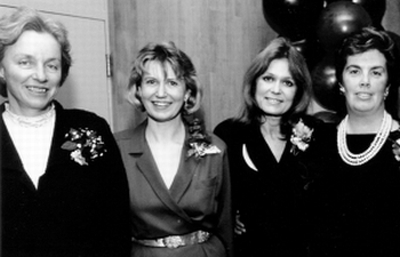 (Host) In observation of Women’s History Month, we conclude our series
(Host) In observation of Women’s History Month, we conclude our series
about some of the women who’ve worked
in journalism in Vermont. This morning we hear from Rickey Gard
Diamond, who recalls how the magazine, Vermont Woman, got its start.
(Diamond)
I’m not happy being old enough to be history myself now, but I do enjoy
telling the story of the founding of the newspaper Vermont Woman –
that’s still publishing today. Suzanne Gillis put her own money on the
line as publisher, and then got investors and advertisers to go on
supporting women’s voices within Vermont’s formidable press corps.
Our
first advisory board included novelist Liza Alther and lawyer, now
judge Amy Davenport; also Sister Elizabeth Candon, former Secretary of
Vermont’s Agency of Human Services, and Lynn Heglund, then head of the
Governor’s Commission on Women, who that year would oversee the passage
of 20 statutes improving the legal status of women.
Yet we
thought it was important that no one woman be singled out for our first
cover. So we chose ten women of different ages and ethnicities, in
wildly different endeavors ranging from farming to governing, homemaking
and construction.
Today, women permeate Vermont news, and Sue
is no longer the only woman publisher in the state. But back then, women
entrepreneurs, athletes, scholars and policy-makers were only emerging.
So our initiative was doubly important.
When the first edition
came out in the fall of 1985, we went out on street corners, dressed in
tuxedos and sparkly red bowler hats to give papers to everyone. Maggie
Maurice, the gossipy Burlington Free Press columnist helped create
anticipation and our picture made the Free Press front page. I was the
founding editor and still have on my office wall the letter from the
Governor congratulating us.
Just the year before, Madeleine
Kunin had become the first woman elected to that office. Her portrait in
the Vt. Statehouse remains the only woman in the Governors’ gallery.
But our paper was the first to notice the equitable numbers of women she
appointed throughout her government – a precedent so remarkable no
governor since has been able to go back to old standards that for the
most part had excluded women.
That year, the biggest item to
report was The Equal Rights Amendment. At first, 71 percent of
Vermonters said they favored the ERA, but by November, 1986, the
amendment went down in defeat. The scare was unisex bathrooms and gay
people marrying.
Gloria Steinem, a founder of Ms.  Magazine, came
Magazine, came
to our newspaper’s anniversary party soon after and reminded us
Vermont’s vote had been the narrowest in the country. The Governor and
22 women who had been on that first year’s covers celebrated with
hundreds of friends the 95 women writers and 410 advertisers who had
supported our efforts that year.
Some say the Women’s movement
did so well that the human dignity of each man, woman and child,
whatever his or her color or sexuality, now seem self-evident in a civil
society.
But women must continue to write, publish, dance
another kind of revolution and sing urges larger than fear. We must
stand on street corners in our red bowler hats and tuxedos and give all
the people the best that we’ve got.